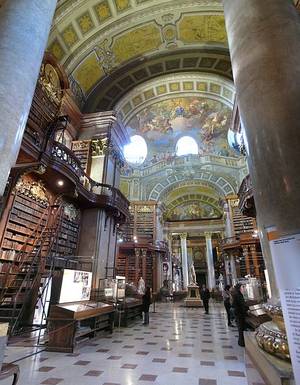Austrian National Library

Austrian National Library With about 8 million books and objects the Austrian National Library (ÖNB) is the biggest library in Austria, located in the Hofburg Vienna. Apart from 3.6 million books, the library is equipped with an array of internationally considerable special collections:
- Department of papyri (UNESCO “memory of the world”, 180,000 objects)
- Department of Manuscripts and Rare Books (combines the “Department of Manuscripts, Autographs and Closed Collection” with the “Department of Incunabula, Old and Rare Books”)
- Picture Archives and Graphics Department (Austria’s biggest location of pictorial documentation with about 2 million objects from different historic media)
- Map Department (administers about 45,000 geographic-topographic views, 800,000 picture postcards, 650 globes, 81,000 volumes of technical literature and atlases etc.)
- Department of Music (Austria’s biggest musical archives, valuable original musical manuscripts as well as modern scholarly research library) • Department of Planned Languages (library of the Esperanto Museum, founded in 1927) • Literary Archives (gathers lifetime and posthumous bequest of Austrian authors beginning with the 20th century, especially after 1945)
The beginnings of the Austrian National Library can be dated back to the Middle Ages. It emerged from the Court Library of the Habsburg Emperors, among whom especially Count Albrecht III (1350–1395), Emperor Friedrich III (1415–1493) and his son Maximilian I (1454–1519) should be mentioned.
The oldest verifiable book, which was written for Count Albrecht III, is a magnificent medieval manuscript, the so called "Evangeliar des Johannes von Troppau" (Book of Gospels), from the year 1368. Emperor Friedrich III brought valuable volumes to his residence in Wiener Neustadt, among them the Prague Wenceslaus Bible (Book of Gospels) and a copy of the Golden Bull of 1356, which regulated the whole election process of the Roman Emperors in great detail.
Maximilian I, himself author of a number of books, increases the Library through his marriages, too. Maria of Bourgogne contributes important volumes written in Burgundian and French book art to the Habsburg property (Book of Hours, Chronicles of Jerusalem, book of Statutes from the Order of the Golden Fleece), and Bianca Maria Sforza adds treasures from the Italian Illumination.
Valuable possessions used to be in the emperor’s immediate proximity, while the inventories in the Viennese Castle were of rather scientific character. During the 16th century, the Library is particularly increased by scholar libraries. In 1575 Hugo Blotius (1534–1608), a Dutch scholar, is appointed the first official librarian of the Imperial Library, which by then contains already about 9000 volumes.
The also political function of the Imperial Library is underlined by an imperial edict by Ferdinand II dated from August 26th, 1624. Thereby the delivery of an obligatory copy of every book offered on the Frankfurt spring and autumn fair becomes mandatory. But the important increases are still done by purchase, partly whole libraries were bought.
In the years of 1723 –1725, Emperor Karl VI (1685–1740) builds a representative library after blueprints from Johann Bernhard Fischer von Erlach. The State Hall, endowed with magnifiscent frescoes, until the 19th century accommodates all publications like early manuscripts and early printed books, among them also the library of Prince Eugene of Savoy, together about 200,000 volumes.
Through the rise of the universities during the 19th century, the scientific value of the Imperial Library gains in importance, as compared to its representative character. In 1906, the Augustinian reading room is opened, in which nowadays the early manuscripts and early printed books still can be read. In 1920, the Imperial Library has become part of history, while under the name of National Library and from 1945 on as Austrian National Library it has continued to exist.
Sources:
http://www.onb.ac.at/about/geschichte.htm
http://www.onb.ac.at/bibliothek.htm
http://de.wikipedia.org/wiki/österreichische_Nationalbibliothek
image source:
http://commons.wikimedia.org/wiki/File:Rathaus_Vienna_June_2006_165.jpg





